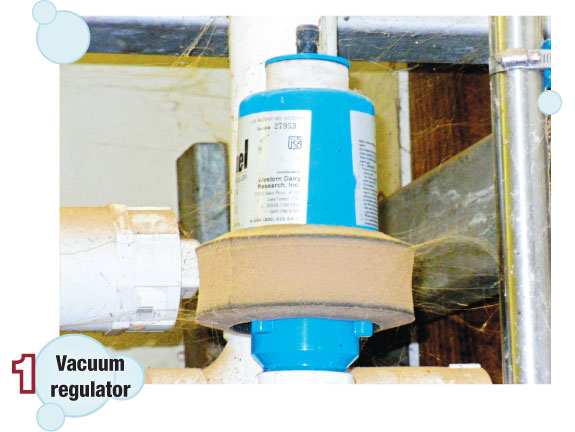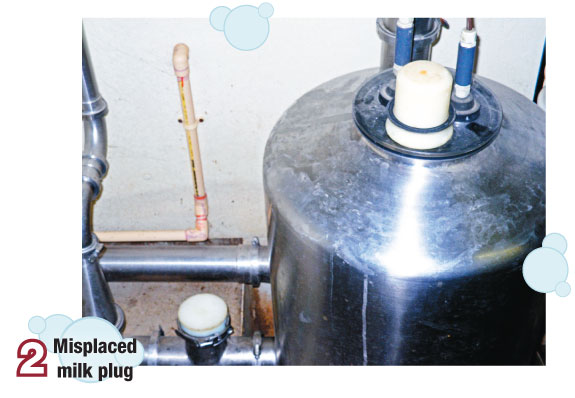Hospital pens are supposed to help cows recover, not contribute to additional health problems and longer downtime. Unfortunately, a 2,000-cow Pennsylvania dairy operation we recently visited had an alarming number of repeat visitors and prolonged recovery times in their hospital pen. This dairy normally averages about 50 cows in the hospital barn. During our visit, that number approached almost 200 cows, and a majority of them had mastitis.
While the dairy producer did a good job with his milking parlor and maintenance system in the main barn, we found several CIP challenges in the hospital barn, where hospital cows were milked in the parlor that was replaced when the dairy expanded.
Often, these old, replaced parlors have neglected maintenance procedures that tend to overly stress milking equipment that was already worn and tired. Such was the case here.

Let’s start with a photo of the vacuum regulator
Note the white filter on the top and the black filter on the bottom of the vacuum regulator…are you having a hard time finding the filters through all the dust, dirt and cobwebs? They need to be cleaned and maintained. These filters have an effect on milkability and overall sanitation.
On this dairy, the dirty filters were hindering the vacuum regulator’s efficiency, so the regulator couldn’t maintain proper system vacuum. This problem then contributed to overmilking and teat irritation. While these are subtle problems, they can have a domino effect when an already-stressed cow’s immune system is challenged even more.
Paying attention to simple details like cleaning a filter can pay big dividends and help cows get on the road to recovery.

What’s wrong with photo 2?
Why is the milk plug sitting on top of the receiver during the wash cycle? It should be getting cleaned. Note the red bacteria growth on the milk plug.
Hospital cows are often under stress, and their immune systems are easily jeopardized. It’s essential to maintain cleanliness and eliminate bacteria sources from coming in contact with these vulnerable cows.
During our visit, we watched a milker pick up the dirty milk plug and replace it in the pipeline. Then he started milking. The bacteria from the milk plug were most likely transferred to the first hospital cow’s teats via the milker’s gloved hands.
When we spoke to the hospital barn milking team, they informed us that they often forget to clean the milk plug. We encouraged the owner to assign the most competent and reliable milkers to his hospital barn to ensure excellent milking and sanitation procedures.
We also trained the milkers on proper CIP practices and told the producer to check the hospital barn’s CIP system as often as the main parlor to ensure proper function.
Keep fresh cows out
We reviewed all 200 hospital pen cows with the producer and his herd manager on this Pennsylvania dairy. The group consisted of lame cows, mastitic cows, treated cows, etc. The group also included some just-fresh cows.
I believe that just-fresh cows should never enter the hospital pen with sick cows. Nor should they be milked with the hospital string. Fresh cows can be very stressed and often are most susceptible to infections, especially mastitis.
We’ve seen too many milkers and milking machines in hospital barns highly contaminated with bacteria. And we believe many cases of mastitis start in the hospital pen when fresh and sick cows are intermingled. Whenever and wherever possible, a separate just-fresh cow area is key to getting cows off to a good start – and maximizing profits.
Discharged from the hospital
I recently checked back with the Pennsylvania producer. He said he’s been paying more attention to CIP details and was happy to say there were now less than 80 cows in the hospital barn, down from almost 200. He’s looking forward to reducing that number even more as things improve.
In addition, herd death loss decreased from 7 percent to 4 percent, involuntary culling dropped from 20 percent to about 15 percent, and production has increased more than 5 pounds per cow per day.
Along with CIP improvements, he also is working on a new aggressive fresh cow program with the help of his veterinarian. More time spent with fresh cows, along with a separate fresh-cow pen, has been a significant investment for this producer, but one he anticipates will provide continued returns in improved cow health, additional cows in the parlor and more milk in the tank.
Whole-farm approach
From the hospital barn to the calf hutches, heifer pens, main barn and more, I can’t stress enough the importance of evaluating, cleaning and monitoring all areas of your dairy. Maintaining a clean environment overall can reduce the incidence of mastitis, improve milk quality, increase profits – and keep cows out of the hospital barn. PD
Want to know how well your CIP system is doing?
Submit a photo of your CIP challenges or a question to Progressive Dairyman . In future issues, A&L Laboratories experts will comment on the photos or questions. Dairy names and locations will not be connected with photos, so your review will be completely anonymous. Send your photos and questions to walt@progressivedairy.com

-
Ron Robinson
- VP Business Development
- A&L Laboratories
- Email Ron Robinson





